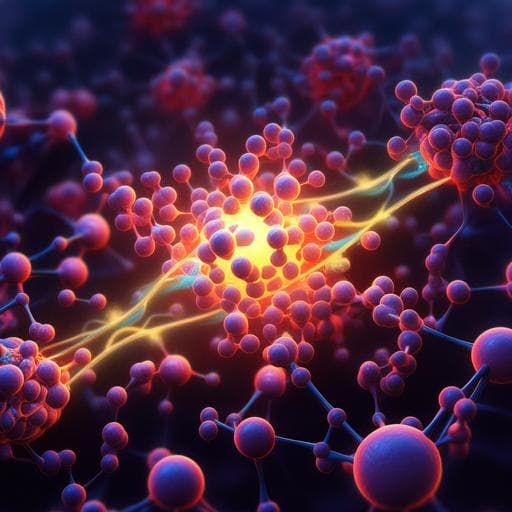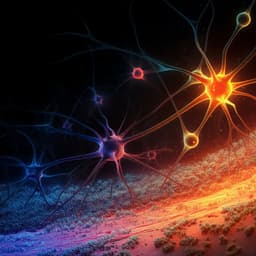
Engineering and Technology
Understanding the charge transfer effects of single atoms for boosting the performance of Na-S batteries
Y. Lei, X. Lu, et al.
This innovative study explores a groundbreaking single-atom-charging strategy to enhance the conductivity of room temperature sodium-sulfur batteries, a promising solution for energy storage. The authors have demonstrated how manganese single-atom catalysts can significantly improve electrochemical performance, targeting the long-standing issues of sulfur conductivity and problematic cathodic products.
~3 min • Beginner • English
Introduction
The study addresses a core challenge in room-temperature sodium–sulfur (RT Na–S) batteries: sluggish and uncontrolled sulfur redox due to the poor conductivity of S8 and the formation of metastable, soluble long-chain sodium polysulfides (Na2Sx, 4 ≤ x ≤ 8) that cause active-material loss, interfacial degradation, shuttle effect, and capacity fade. While Na–S technology promises high energy density (up to 1274 Wh kg−1) and low cost compared to Li-based systems, achieving controlled product pathways and fast kinetics remains difficult. The authors propose that tailoring catalyst electronic structures to optimize adsorption strength and electron-transfer (ET) capability can guide reaction pathways toward stable short-chain polysulfides (Na2S4 → Na2S2/Na2S), suppressing undesirable intermediates and enhancing reversibility. They hypothesize that single-atom catalysts (SACs) with mild adsorption and fast ET (guided by Sabatier and Marcus theories) will accelerate sulfur cleavage, improve product selectivity to short-chain species, and boost Na+ transport through charge-transfer-assisted ion rearrangement.
Literature Review
The paper situates its contribution within extensive work on Na–S batteries addressing shuttle mitigation, cathode design, and catalysis. Prior research emphasizes the detrimental role of long-chain polysulfides in ether/ester electrolytes, kinetically sluggish short-chain conversion, and the need for catalysts to regulate reaction pathways. Product selectivity, widely discussed in heterogeneous catalysis (e.g., CO2 reduction, hydrogenation, toluene oxidation), has been less explored for Na–S batteries. Previous Na–S strategies (novel hosts, separators, catalysts, and external fields) improved performance but did not systematically correlate catalyst electronic structure with pathway selectivity. This study leverages Sabatier and Marcus frameworks and combines DFT with machine learning to identify SAC descriptors (e.g., M–S bond length, adsorption energies) predictive of product selectivity, addressing a gap in understanding how ET capability and adsorption govern NaPS formation and reversibility.
Methodology
- Catalyst screening and theory: Applied Sabatier principle to target mild adsorption within the electrochemical potential window relevant to Na–S (−1.91 to −0.61 eV vs RHE). Used Marcus theory to rationalize ET kinetics in relation to reorganization energy and donor–acceptor distance. Employed machine learning (linear regression, random forest, gradient boosting, SVR, kernel ridge) trained on 123 DFT-calculated adsorption energies for MN4 and MC1N3 sites to correlate M–S bond length and adsorption energies with catalytic selectivity; predicted promising SACs (e.g., Mn–N4, Fe–N4, Rh–N4, Mg–N4, Co–N4, Mg–C1N3).
- Experimental SAC synthesis: Prepared single-atom metals (Mn, Fe, Co, Sn, Ni, Cu) on porous N-doped carbon nanospheres (M1-PNC) via dopamine polymerization followed by carbonization (typically 300 °C 2 h then 800 °C 2 h in N2; Fe1-PNC carbonized at 600 °C). Sulfur was infused to form S@M1-PNC by melt-diffusion (155 °C 12 h then 300 °C 2 h; S:host = 1.5:1 by mass).
- Physical characterization: SEM/STEM (HAADF/ABF) for morphology and single-atom dispersion; atom probe tomography (LEAP 5000XR) for 3D elemental distribution; XAFS (XANES/EXAFS) to determine oxidation state and coordination (e.g., Mn–N4, Mn2+); TGA for S content; EDX mapping; TOF-SIMS for Na/S spatial distribution after cycling; in-situ TEM and SAED to track sodiation/desodiation and phase evolution; synchrotron in-situ XRD to monitor phase transitions during cycling.
- Electrochemical testing: Coin cells with Na metal anode, Whatman GF/F separator, electrolyte 1 M NaClO4 in EC/PC (1:1 v/v) with 5 wt% FEC; voltage window 0.8–2.8 V at 25 °C. Cathode slurry: active:Supper P:CMC = 7:1.5:1.5 in water, coated on Cu, loading ~2.6 mg cm−2. Assessed initial discharge/charge profiles, rate capability (0.1–5 A g−1), and cycling stability (e.g., 0.2 A g−1 up to 120 cycles; 2 A g−1 up to 3000 cycles).
- Spectroscopic ET probing: Ex-situ XANES at Mn and Ni K-edges during discharge/charge to track white-line shifts as proxies for ET (donation/acceptance) between SACs and S species.
- DFT calculations: Spin-polarized VASP with PBE-GGA, PAW, 450 eV cutoff, D3 dispersion, 6×6×1 graphene supercell embedding MN4; convergence 1e−5 eV, 0.02 eV Å−1; NEB for barriers; computed adsorption energies for S8, Na2Sx (x = 2,4,6,8) on Mn1 and Ni1; analyzed d-band centers and DOS relative to Fermi level.
- Machine learning: Trained models using elemental features and DFT-derived adsorption energies to predict Eads vs M–S bond length, enabling rapid SAC screening for mild adsorption and fast ET.
Key Findings
- Pathway selectivity: S@Mn1-PNC exhibits dominant low-plateau capacity (Na2S4 → Na2S2/Na2S) accounting for 88.6% of discharge capacity; Fe1 81.7%; Co1 67%; Sn1 64%; Ni1 and Cu1 dominated by high-plateau (S → Na2S6) indicative of long-chain NaPS formation.
- Electrochemical performance: At 0.2 A g−1 for 120 cycles, S@Mn1-PNC retained 784.6 mAh g−1 (84% retention), outperforming Fe1 (77.6%), Co1 (65.3%), Sn1 (62.8%), Ni1 (55%), Cu1 (53%). Rate capability for S@Mn1-PNC: 989, 901, 814, 776, 678, 576 mAh g−1 at 0.1, 0.2, 0.5, 1, 2, 5 A g−1; recovery to 890 mAh g−1 when returned to 0.1 A g−1. Long-term: 344.1 mAh g−1 after 3000 cycles at 2 A g−1.
- In-situ/Ex-situ phase tracking: With Mn1, in-situ XRD shows direct S → Na2S4 → Na2S2 → Na2S during discharge; no long-chain NaPS detected; Na2S peak disappears upon charge (reversible), unlike Ni1 where irreversible Na2S remains. S K-edge XANES confirms reversible short-chain chemistry with Mn1.
- Electron transfer evidence: Mn K-edge XANES shows a pre-edge feature (~6537.8 eV) and white-line shifts indicating rapid electron donation at higher voltages (shift ~+0.63 eV at 2.0 V) and continued donation to 1.2/0.8 V; during charging, Mn accepts electrons (shifts to lower energy). Ni shows negligible high-voltage ET and limited low-voltage ET; counterproductive behavior during charge near 0.8–1.2 V.
- Structure stability: FT-EXAFS of Mn maintains a single Mn–N peak at ~1.65 Å with slight shift during discharge (indicative of catalytic interaction and facilitated desorption), recovering on charge; wavelet transforms show consistent intensity maxima (~4.0 Å−1), indicating structural stability of Mn–N4 sites.
- Ion transport: In-situ TEM shows earlier reaction inside Mn1-PNC spheres during discharge consistent with ET-enhanced electrostatic Na+ adsorption; Mn1 reduces Na+ diffusion barriers vs PNC alone (DFT), facilitating sodiation/desodiation. SAED confirms Na2S formation during discharge and its evolution upon charge.
- DFT/ML insights: Mn1 has stronger adsorption for S8 and Na2S than Ni1 and features a d-band center closer to the Fermi level with less-filled antibonding states, favoring S–S bond cleavage and faster kinetics; ML confirms linear relationships between Eads and M–S bond length, enabling rapid SAC screening; predicted optimal region includes Mn–N4, Fe–N4, Rh–N4, Mg–N4, Co–N4, Mg–C1N3.
Discussion
The findings validate the hypothesis that catalyst electronic structure—specifically the ability to mediate fast, bidirectional electron transfer while maintaining mild adsorption—governs product pathway selectivity in RT Na–S batteries. Mn single-atom sites (Mn–N4) effectively donate electrons to promote rapid cleavage of S8 and long-chain polysulfides into short-chain Na2S4/Na2S2/Na2S during discharge, while also accepting electrons from solid short-chain products during charge, enhancing reversibility and mitigating accumulation of irreversible Na2S. This selective pathway suppresses soluble long-chain intermediates, reduces shuttle and parasitic reactions, and accelerates the rate-determining low-plateau processes, translating into superior rate capability, high capacity retention, and ultra-long cycling stability. Spectroscopic tracking (XANES, EXAFS) directly correlates SAC-dependent ET signatures with reaction pathway control, while in-situ XRD/TEM/SAED and TOF-SIMS corroborate uniform reaction distribution, structural stability, and improved Na+ transport aided by ET-induced ion rearrangement. The integrated ML–DFT–experiment approach establishes actionable descriptors (M–S bond length, Eads, d-band position) for rational SAC design in Na–S systems.
Conclusion
This work introduces a single-atom-charging strategy that links adsorption strength and electron-transfer capability to product-selective Na–S redox. Guided by ML and DFT, Mn single-atom catalysts supported on porous N-doped carbon nanospheres achieve high selectivity toward short-chain NaPSs, fast kinetics in the low-plateau region, and exceptional electrochemical performance (e.g., 84% capacity retention over 120 cycles at 0.2 A g−1; 344.1 mAh g−1 after 3000 cycles at 2 A g−1). Spectroscopic evidence confirms Mn’s superior ability to donate and accept electrons across the operational voltage window, enabling reversible conversion between S species and stabilizing the cathode structure. The study provides design principles and screening tools (M–S bond length, adsorption energy, d-band center proximity to EF) for discovering efficient SACs for Na–S and related conversion chemistries. Future work could explore broader SAC chemistries (including non-transition metals and dual-atom sites), varied supports and coordination environments, electrolyte optimization, higher sulfur loadings and lean-electrolyte conditions, and in-depth operando ET/ion-transport studies to further generalize the strategy.
Limitations
- The experimental validation focuses on six SACs (Mn, Fe, Co, Sn, Ni, Cu) on a single PNC support and one coordination motif (predominantly MN4); broader chemistries and supports remain to be explored.
- Electrochemical testing uses a specific carbonate-based electrolyte (1 M NaClO4 in EC/PC with 5 wt% FEC) and moderate sulfur loading (~2.6 mg cm−2); performance and selectivity may vary with electrolyte systems, higher areal loadings, and lean-electrolyte conditions.
- While in-situ/operando characterizations are comprehensive, direct, fully operando ET kinetics quantification (e.g., interfacial charge-transfer resistance evolution) and universality across different cell formats were not exhaustively addressed.
Related Publications
Explore these studies to deepen your understanding of the subject.







